steering wheel FIAT TALENTO 2020 Owner handbook (in English)
[x] Cancel search | Manufacturer: FIAT, Model Year: 2020, Model line: TALENTO, Model: FIAT TALENTO 2020Pages: 236, PDF Size: 4.86 MB
Page 100 of 236
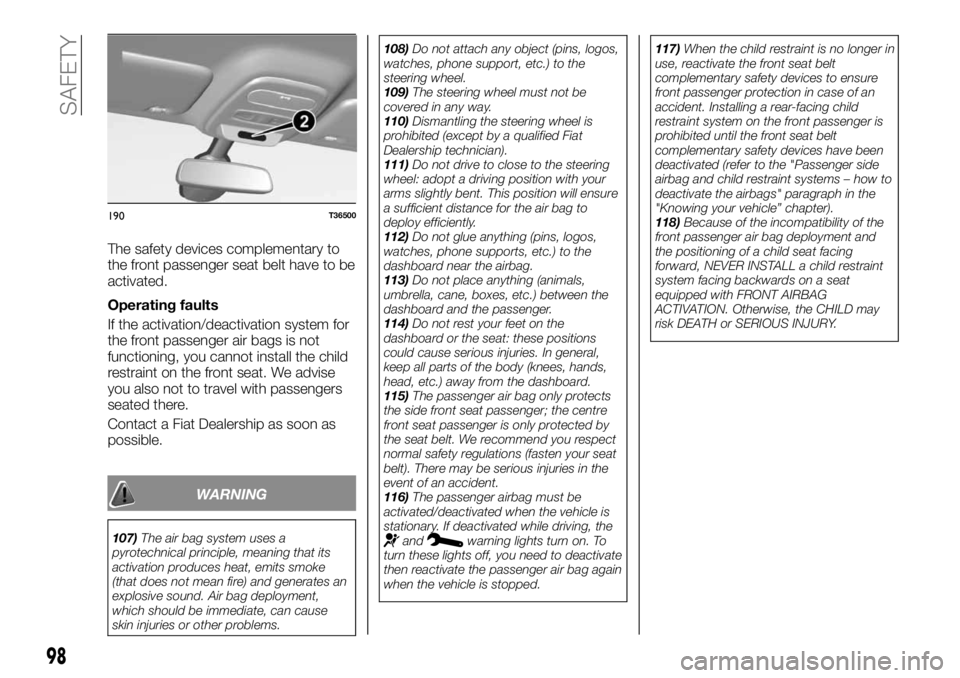
The safety devices complementary to
the front passenger seat belt have to be
activated.
Operating faults
If the activation/deactivation system for
the front passenger air bags is not
functioning, you cannot install the child
restraint on the front seat. We advise
you also not to travel with passengers
seated there.
Contact a Fiat Dealership as soon as
possible.
WARNING
107)The air bag system uses a
pyrotechnical principle, meaning that its
activation produces heat, emits smoke
(that does not mean fire) and generates an
explosive sound. Air bag deployment,
which should be immediate, can cause
skin injuries or other problems.108)Do not attach any object (pins, logos,
watches, phone support, etc.) to the
steering wheel.
109)The steering wheel must not be
covered in any way.
110)Dismantling the steering wheel is
prohibited (except by a qualified Fiat
Dealership technician).
111)Do not drive to close to the steering
wheel: adopt a driving position with your
arms slightly bent. This position will ensure
a sufficient distance for the air bag to
deploy efficiently.
112)Do not glue anything (pins, logos,
watches, phone supports, etc.) to the
dashboard near the airbag.
113)Do not place anything (animals,
umbrella, cane, boxes, etc.) between the
dashboard and the passenger.
114)Do not rest your feet on the
dashboard or the seat: these positions
could cause serious injuries. In general,
keep all parts of the body (knees, hands,
head, etc.) away from the dashboard.
115)The passenger air bag only protects
the side front seat passenger; the centre
front seat passenger is only protected by
the seat belt. We recommend you respect
normal safety regulations (fasten your seat
belt). There may be serious injuries in the
event of an accident.
116)The passenger airbag must be
activated/deactivated when the vehicle is
stationary. If deactivated while driving, theandwarning lights turn on. To
turn these lights off, you need to deactivate
then reactivate the passenger air bag again
when the vehicle is stopped.117)When the child restraint is no longer in
use, reactivate the front seat belt
complementary safety devices to ensure
front passenger protection in case of an
accident. Installing a rear-facing child
restraint system on the front passenger is
prohibited until the front seat belt
complementary safety devices have been
deactivated (refer to the "Passenger side
airbag and child restraint systems – how to
deactivate the airbags" paragraph in the
"Knowing your vehicle” chapter).
118)Because of the incompatibility of the
front passenger air bag deployment and
the positioning of a child seat facing
forward, NEVER INSTALL a child restraint
system facing backwards on a seat
equipped with FRONT AIRBAG
ACTIVATION. Otherwise, the CHILD may
risk DEATH or SERIOUS INJURY.
190T36500
98
SAFETY
Page 128 of 236
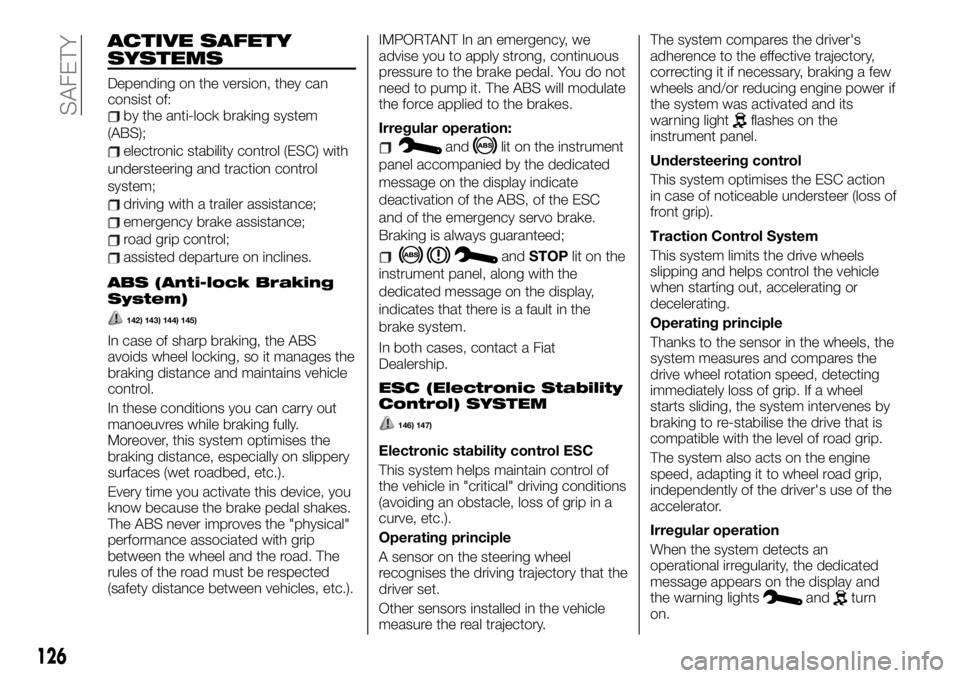
ACTIVE SAFETY
SYSTEMS
Depending on the version, they can
consist of:
by the anti-lock braking system
(ABS);
electronic stability control (ESC) with
understeering and traction control
system;
driving with a trailer assistance;
emergency brake assistance;
road grip control;
assisted departure on inclines.
ABS (Anti-lock Braking
System)
142) 143) 144) 145)
In case of sharp braking, the ABS
avoids wheel locking, so it manages the
braking distance and maintains vehicle
control.
In these conditions you can carry out
manoeuvres while braking fully.
Moreover, this system optimises the
braking distance, especially on slippery
surfaces (wet roadbed, etc.).
Every time you activate this device, you
know because the brake pedal shakes.
The ABS never improves the "physical"
performance associated with grip
between the wheel and the road. The
rules of the road must be respected
(safety distance between vehicles, etc.).IMPORTANT In an emergency, we
advise you to apply strong, continuous
pressure to the brake pedal. You do not
need to pump it. The ABS will modulate
the force applied to the brakes.
Irregular operation:
andlit on the instrument
panel accompanied by the dedicated
message on the display indicate
deactivation of the ABS, of the ESC
and of the emergency servo brake.
Braking is always guaranteed;
andSTOPlit on the
instrument panel, along with the
dedicated message on the display,
indicates that there is a fault in the
brake system.
In both cases, contact a Fiat
Dealership.
ESC (Electronic Stability
Control) SYSTEM
146) 147)
Electronic stability control ESC
This system helps maintain control of
the vehicle in "critical" driving conditions
(avoiding an obstacle, loss of grip in a
curve, etc.).
Operating principle
A sensor on the steering wheel
recognises the driving trajectory that the
driver set.
Other sensors installed in the vehicle
measure the real trajectory.The system compares the driver's
adherence to the effective trajectory,
correcting it if necessary, braking a few
wheels and/or reducing engine power if
the system was activated and its
warning light
flashes on the
instrument panel.
Understeering control
This system optimises the ESC action
in case of noticeable understeer (loss of
front grip).
Traction Control System
This system limits the drive wheels
slipping and helps control the vehicle
when starting out, accelerating or
decelerating.
Operating principle
Thanks to the sensor in the wheels, the
system measures and compares the
drive wheel rotation speed, detecting
immediately loss of grip. If a wheel
starts sliding, the system intervenes by
braking to re-stabilise the drive that is
compatible with the level of road grip.
The system also acts on the engine
speed, adapting it to wheel road grip,
independently of the driver's use of the
accelerator.
Irregular operation
When the system detects an
operational irregularity, the dedicated
message appears on the display and
the warning lights
andturn
on.
126
SAFETY
Page 135 of 236
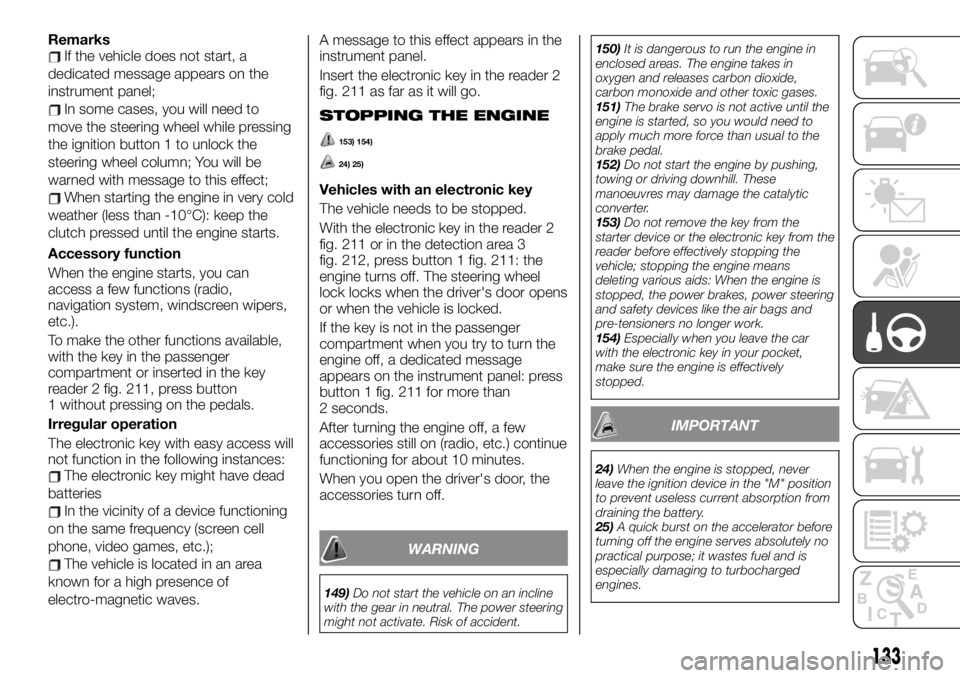
RemarksIf the vehicle does not start, a
dedicated message appears on the
instrument panel;
In some cases, you will need to
move the steering wheel while pressing
the ignition button 1 to unlock the
steering wheel column; You will be
warned with message to this effect;
When starting the engine in very cold
weather (less than -10°C): keep the
clutch pressed until the engine starts.
Accessory function
When the engine starts, you can
access a few functions (radio,
navigation system, windscreen wipers,
etc.).
To make the other functions available,
with the key in the passenger
compartment or inserted in the key
reader 2 fig. 211, press button
1 without pressing on the pedals.
Irregular operation
The electronic key with easy access will
not function in the following instances:
The electronic key might have dead
batteries
In the vicinity of a device functioning
on the same frequency (screen cell
phone, video games, etc.);
The vehicle is located in an area
known for a high presence of
electro-magnetic waves.A message to this effect appears in the
instrument panel.
Insert the electronic key in the reader 2
fig. 211 as far as it will go.
STOPPING THE ENGINE
153) 154)
24) 25)
Vehicles with an electronic key
The vehicle needs to be stopped.
With the electronic key in the reader 2
fig. 211 or in the detection area 3
fig. 212, press button 1 fig. 211: the
engine turns off. The steering wheel
lock locks when the driver's door opens
or when the vehicle is locked.
If the key is not in the passenger
compartment when you try to turn the
engine off, a dedicated message
appears on the instrument panel: press
button 1 fig. 211 for more than
2 seconds.
After turning the engine off, a few
accessories still on (radio, etc.) continue
functioning for about 10 minutes.
When you open the driver's door, the
accessories turn off.
WARNING
149)Do not start the vehicle on an incline
with the gear in neutral. The power steering
might not activate. Risk of accident.150)It is dangerous to run the engine in
enclosed areas. The engine takes in
oxygen and releases carbon dioxide,
carbon monoxide and other toxic gases.
151)The brake servo is not active until the
engine is started, so you would need to
apply much more force than usual to the
brake pedal.
152)Do not start the engine by pushing,
towing or driving downhill. These
manoeuvres may damage the catalytic
converter.
153)Do not remove the key from the
starter device or the electronic key from the
reader before effectively stopping the
vehicle; stopping the engine means
deleting various aids: When the engine is
stopped, the power brakes, power steering
and safety devices like the air bags and
pre-tensioners no longer work.
154)Especially when you leave the car
with the electronic key in your pocket,
make sure the engine is effectively
stopped.
IMPORTANT
24)When the engine is stopped, never
leave the ignition device in the "M" position
to prevent useless current absorption from
draining the battery.
25)A quick burst on the accelerator before
turning off the engine serves absolutely no
practical purpose; it wastes fuel and is
especially damaging to turbocharged
engines.
133
Page 153 of 236
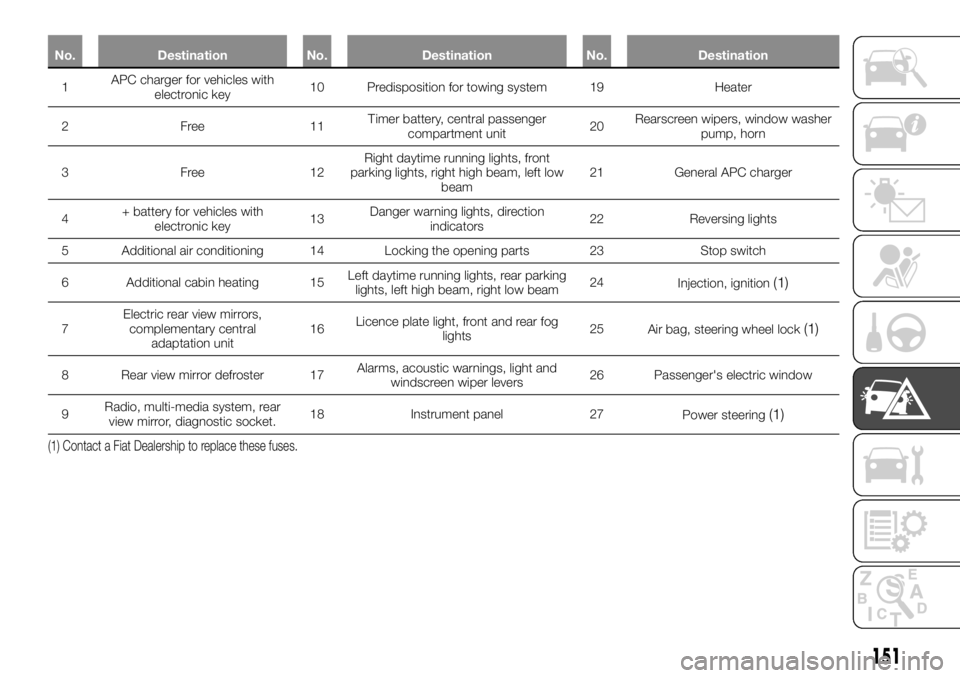
No. Destination No. Destination No. Destination
1APC charger forvehicles with
electronic key10 Predisposition for towing system 19 Heater
2Free11Timer battery, central passenger
compartment unit20Rearscreen wipers, window washer
pump, horn
3Free12Right daytime running lights, front
parking lights, right high beam, left low
beam21 General APC charger
4+ battery for vehicles with
electronic key13Danger warning lights, direction
indicators22 Reversing lights
5 Additional air conditioning 14 Locking the opening parts 23 Stop switch
6 Additional cabin heating 15Left daytime running lights, rear parking
lights, left high beam, right low beam24
Injection, ignition
(1)
7Electric rear view mirrors,
complementary central
adaptation unit16Licence plate light, front and rear fog
lights25
Air bag, steering wheel lock(1)
8 Rear view mirror defroster 17Alarms, acoustic warnings, light and
windscreen wiper levers26 Passenger's electric window
9Radio, multi-media system, rear
view mirror, diagnostic socket.18 Instrument panel 27
Power steering
(1)
(1) Contact a Fiat Dealership to replace these fuses.
151
Page 162 of 236
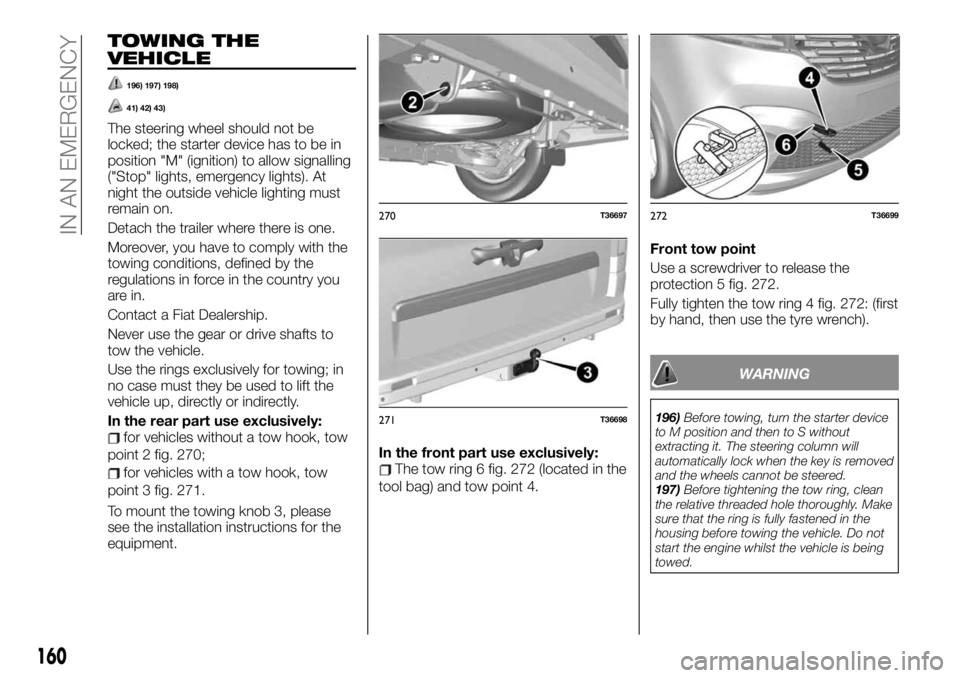
TOWING THE
VEHICLE
196) 197) 198)
41) 42) 43)
The steering wheel should not be
locked; the starter device has to be in
position "M" (ignition) to allow signalling
("Stop" lights, emergency lights). At
night the outside vehicle lighting must
remain on.
Detach the trailer where there is one.
Moreover, you have to comply with the
towing conditions, defined by the
regulations in force in the country you
are in.
Contact a Fiat Dealership.
Never use the gear or drive shafts to
tow the vehicle.
Use the rings exclusively for towing; in
no case must they be used to lift the
vehicle up, directly or indirectly.
In the rear part use exclusively:
for vehicles without a tow hook, tow
point 2 fig. 270;
for vehicles with a tow hook, tow
point 3 fig. 271.
To mount the towing knob 3, please
see the installation instructions for the
equipment.In the front part use exclusively:The tow ring 6 fig. 272 (located in the
tool bag) and tow point 4.Front tow point
Use a screwdriver to release the
protection 5 fig. 272.
Fully tighten the tow ring 4 fig. 272: (first
by hand, then use the tyre wrench).
WARNING
196)Before towing, turn the starter device
to M position and then to S without
extracting it. The steering column will
automatically lock when the key is removed
and the wheels cannot be steered.
197)Before tightening the tow ring, clean
the relative threaded hole thoroughly. Make
sure that the ring is fully fastened in the
housing before towing the vehicle. Do not
start the engine whilst the vehicle is being
towed.
270T36697
271T36698
272T36699
160
IN AN EMERGENCY
Page 178 of 236
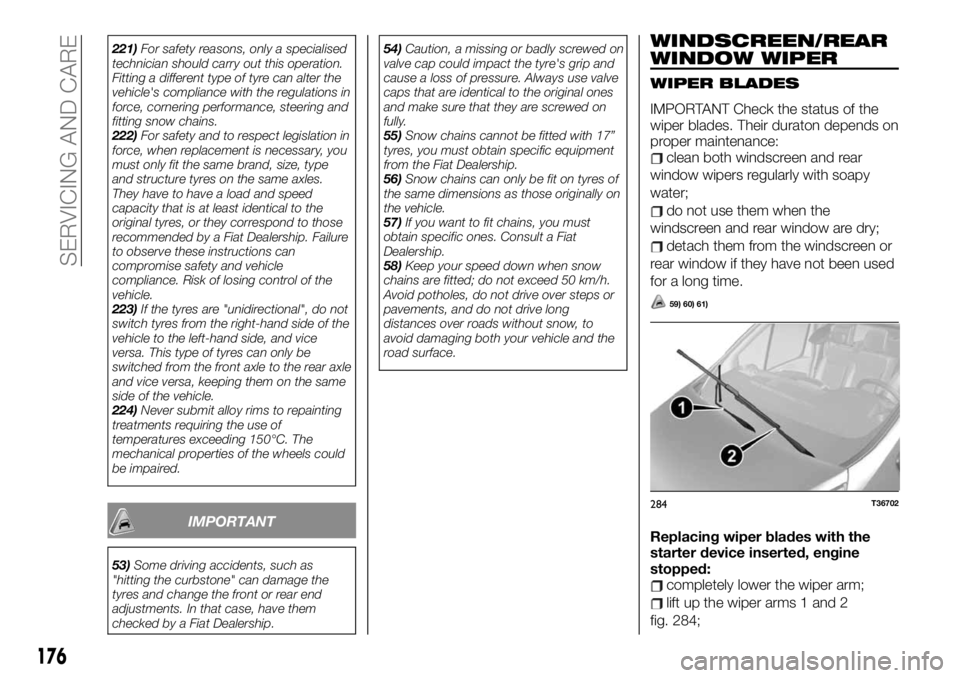
221)For safety reasons, only a specialised
technician should carry out this operation.
Fitting a different type of tyre can alter the
vehicle's compliance with the regulations in
force, cornering performance, steering and
fitting snow chains.
222)For safety and to respect legislation in
force, when replacement is necessary, you
must only fit the same brand, size, type
and structure tyres on the same axles.
They have to have a load and speed
capacity that is at least identical to the
original tyres, or they correspond to those
recommended by a Fiat Dealership. Failure
to observe these instructions can
compromise safety and vehicle
compliance. Risk of losing control of the
vehicle.
223)If the tyres are "unidirectional", do not
switch tyres from the right-hand side of the
vehicle to the left-hand side, and vice
versa. This type of tyres can only be
switched from the front axle to the rear axle
and vice versa, keeping them on the same
side of the vehicle.
224)Never submit alloy rims to repainting
treatments requiring the use of
temperatures exceeding 150°C. The
mechanical properties of the wheels could
be impaired.
IMPORTANT
53)Some driving accidents, such as
"hitting the curbstone" can damage the
tyres and change the front or rear end
adjustments. In that case, have them
checked by a Fiat Dealership.54)Caution, a missing or badly screwed on
valve cap could impact the tyre's grip and
cause a loss of pressure. Always use valve
caps that are identical to the original ones
and make sure that they are screwed on
fully.
55)Snow chains cannot be fitted with 17”
tyres, you must obtain specific equipment
from the Fiat Dealership.
56)Snow chains can only be fit on tyres of
the same dimensions as those originally on
the vehicle.
57)If you want to fit chains, you must
obtain specific ones. Consult a Fiat
Dealership.
58)Keep your speed down when snow
chains are fitted; do not exceed 50 km/h.
Avoid potholes, do not drive over steps or
pavements, and do not drive long
distances over roads without snow, to
avoid damaging both your vehicle and the
road surface.
WINDSCREEN/REAR
WINDOW WIPER
WIPER BLADES
IMPORTANT Check the status of the
wiper blades. Their duraton depends on
proper maintenance:
clean both windscreen and rear
window wipers regularly with soapy
water;
do not use them when the
windscreen and rear window are dry;
detach them from the windscreen or
rear window if they have not been used
for a long time.
59) 60) 61)
Replacing wiper blades with the
starter device inserted, engine
stopped:
completely lower the wiper arm;
lift up the wiper arms 1 and 2
fig. 284;
284T36702
176
SERVICING AND CARE
Page 190 of 236
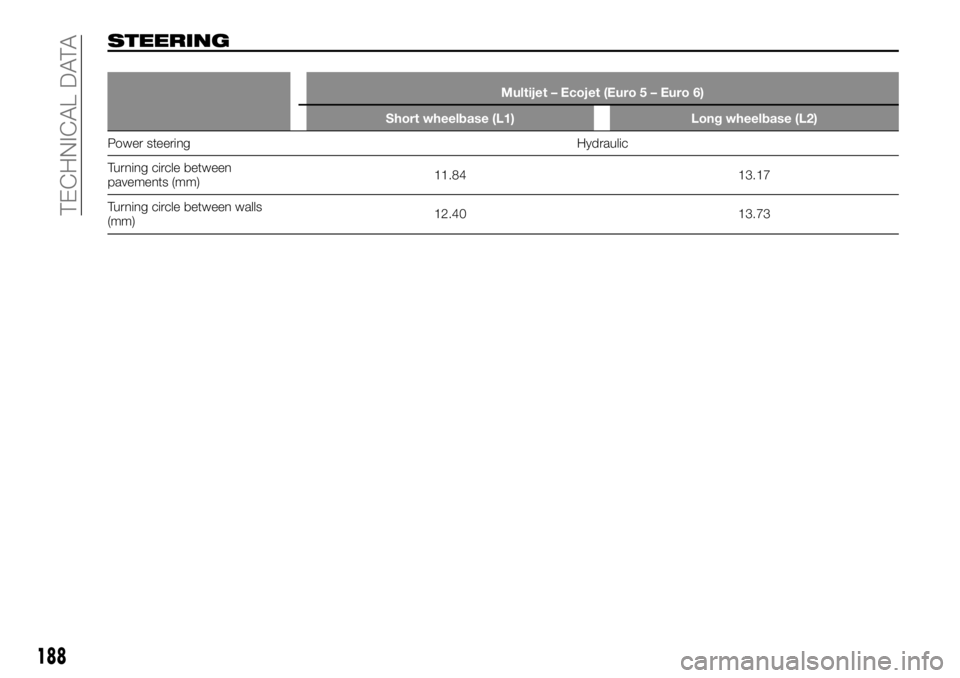
STEERING
Multijet – Ecojet (Euro 5 – Euro 6)
Short wheelbase (L1) Long wheelbase (L2)
Power steering Hydraulic
Turning
circle between
pavements (mm)11.84 13.17
Turning circle between walls
(mm)12.40 13.73
188
TECHNICAL DATA
Page 224 of 236
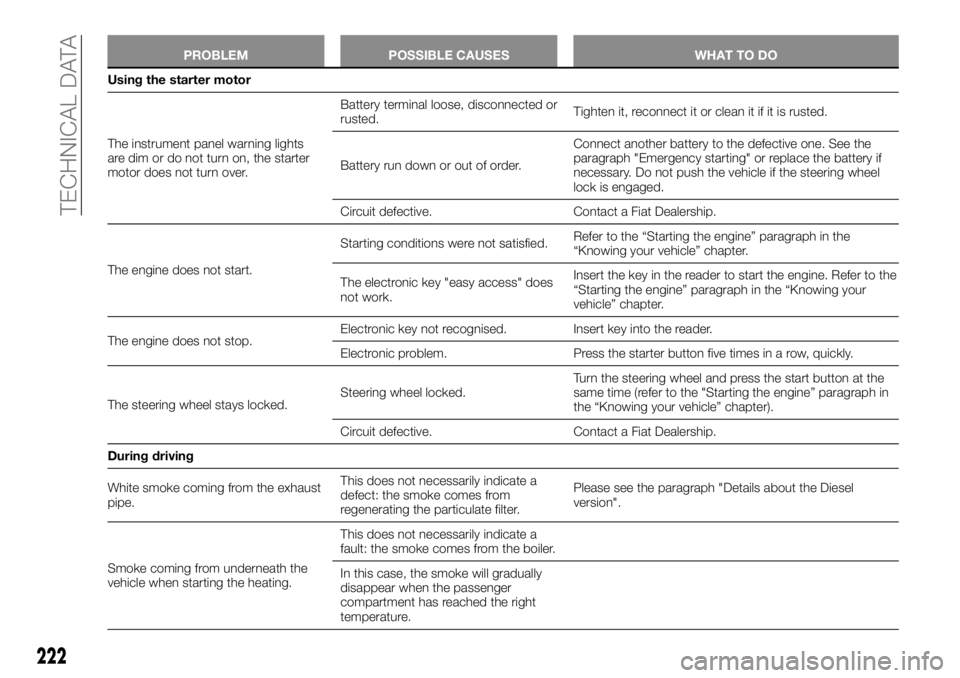
PROBLEM POSSIBLE CAUSES WHAT TO DO
Using the starter motor
The instrument panel
warning lights
are dim or do not turn on, the starter
motor does not turn over.Battery terminal loose, disconnected or
rusted.Tighten it, reconnect it or clean it if it is rusted.
Battery run down or out of order.Connect another battery to the defective one. See the
paragraph "Emergency starting" or replace the battery if
necessary. Do not push the vehicle if the steering wheel
lock is engaged.
Circuit defective. Contact a Fiat Dealership.
The engine does not start.Starting conditions were not satisfied.Refer to the “Starting the engine” paragraph in the
“Knowing your vehicle” chapter.
The electronic key "easy access" does
not work.Insert the key in the reader to start the engine. Refer to the
“Starting the engine” paragraph in the “Knowing your
vehicle” chapter.
The engine does not stop.Electronic key not recognised. Insert key into the reader.
Electronic problem. Press the starter button five times in a row, quickly.
The steering wheel stays locked.Steering wheel locked.Turn the steering wheel and press the start button at the
same time (refer to the "Starting the engine” paragraph in
the “Knowing your vehicle” chapter).
Circuit defective. Contact a Fiat Dealership.
During driving
White smoke coming from the exhaust
pipe.This does not necessarily indicate a
defect: the smoke comes from
regenerating the particulate filter.Please see the paragraph "Details about the Diesel
version".
Smoke coming from underneath the
vehicle when starting the heating.This does not necessarily indicate a
fault: the smoke comes from the boiler.
In this case, the smoke will gradually
disappear when the passenger
compartment has reached the right
temperature.
222
TECHNICAL DATA
Page 225 of 236
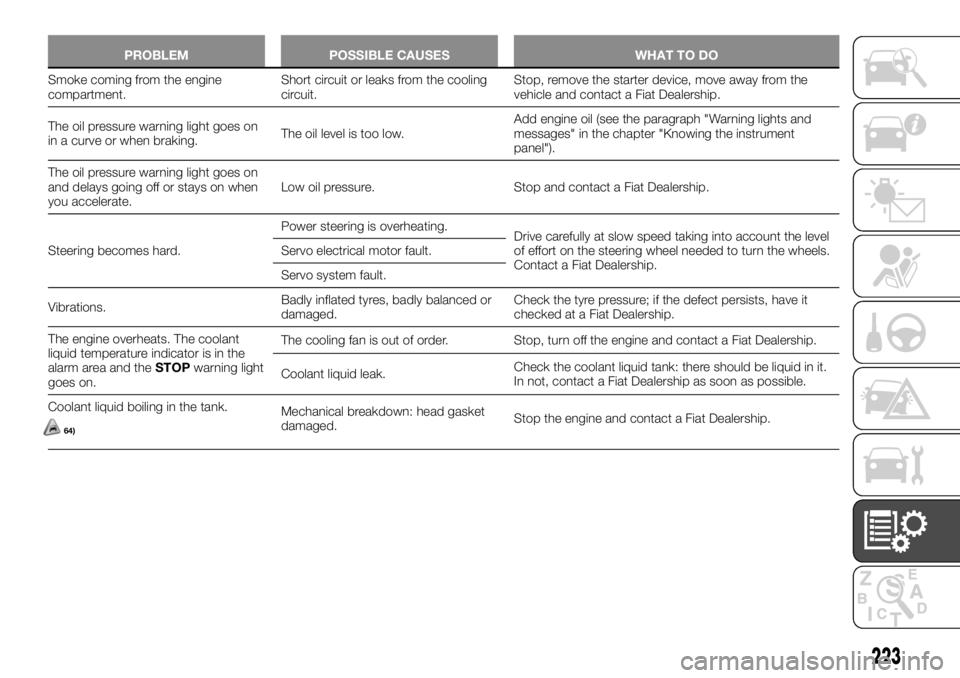
PROBLEM POSSIBLE CAUSES WHAT TO DO
Smoke coming from the engine
compartment.Short circuit or leaks from the cooling
circuit.Stop, remove the starter device, move away from the
vehicle and contact a Fiat Dealership.
The oil pressure warning light goes on
in a curve or when braking.The oil level is too low.Add engine oil (see the paragraph "Warning lights and
messages" in the chapter "Knowing the instrument
panel").
The oil pressure warning light goes on
and delays going off or stays on when
you accelerate.Low oil pressure. Stop and contact a Fiat Dealership.
Steering becomes hard.Power steering is overheating.
Drive carefully at slow speed taking into account the level
of effort on the steering wheel needed to turn the wheels.
Contact a Fiat Dealership. Servo electrical motor fault.
Servo system fault.
Vibrations.Badly inflated tyres, badly balanced or
damaged.Check the tyre pressure; if the defect persists, have it
checked at a Fiat Dealership.
The engine overheats. The coolant
liquid temperature indicator is in the
alarm area and theSTOPwarning light
goes on.The cooling fan is out of order. Stop, turn off the engine and contact a Fiat Dealership.
Coolant liquid leak.Check the coolant liquid tank: there should be liquid in it.
In not, contact a Fiat Dealership as soon as possible.
Coolant liquid boiling in the tank.
64)
Mechanical breakdown: head gasket
damaged.Stop the engine and contact a Fiat Dealership.
223
Page 234 of 236
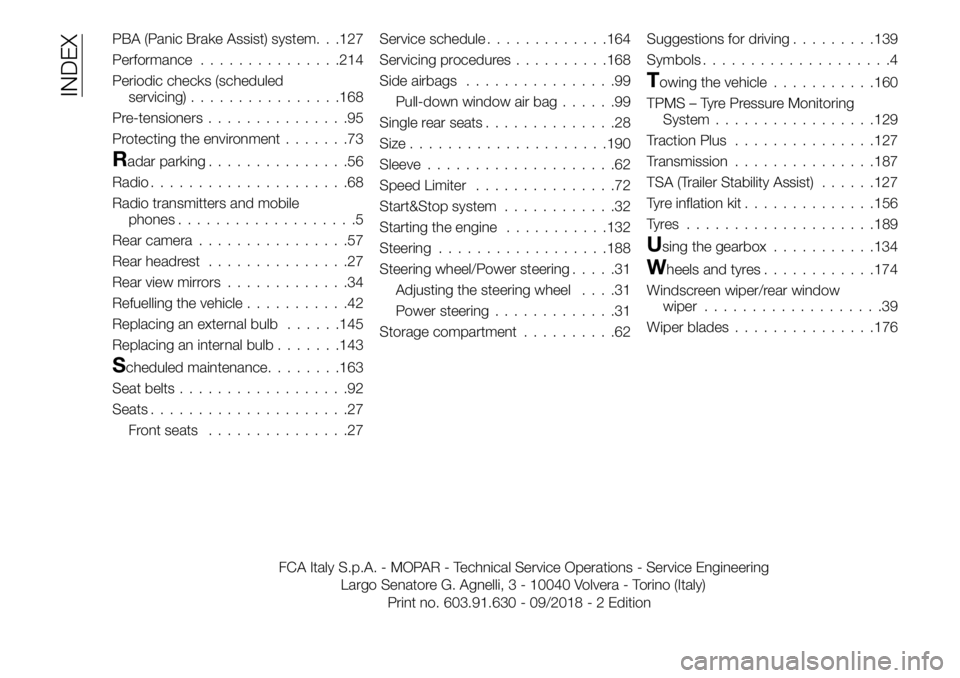
PBA (Panic Brake Assist) system. . .127
Performance...............214
Periodic checks (scheduled
servicing)................168
Pre-tensioners...............95
Protecting the environment.......73
Radar parking...............56
Radio.....................68
Radio transmitters and mobile
phones...................5
Rear camera................57
Rear headrest...............27
Rear view mirrors.............34
Refuelling the vehicle...........42
Replacing an external bulb......145
Replacing an internal bulb.......143
Scheduled maintenance........163
Seat belts..................92
Seats.....................27
Front seats...............27Service schedule.............164
Servicing procedures..........168
Side airbags................99
Pull-down window air bag......99
Single rear seats..............28
Size.....................190
Sleeve....................62
Speed Limiter...............72
Start&Stop system............32
Starting the engine...........132
Steering..................188
Steering wheel/Power steering.....31
Adjusting the steering wheel....31
Power steering.............31
Storage compartment..........62Suggestions for driving.........139
Symbols....................4
Towing the vehicle...........160
TPMS – Tyre Pressure Monitoring
System.................129
Traction Plus...............127
Transmission...............187
TSA (Trailer Stability Assist)......127
Tyre inflation kit..............156
Tyres ....................189
Using the gearbox...........134
Wheels and tyres............174
Windscreen wiper/rear window
wiper...................39
Wiper blades...............176
FCA Italy S.p.A. - MOPAR - Technical Service Operations - Service Engineering
Largo Senatore G. Agnelli, 3 - 10040 Volvera - Torino (Italy)
Print no. 603.91.630 - 09/2018 - 2 Edition
INDEX